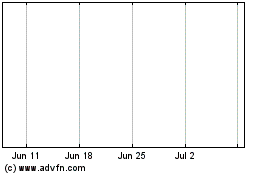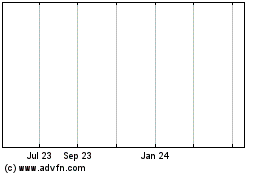By Anupreeta Das And Leslie Scism
A sudden rise in traffic deaths surprised big car insurers in
the first half of 2015, meaning higher premiums for drivers who are
now traveling in record numbers.
Industry executives say the 14% surge in fatal accidents tracked
by the nonprofit National Safety Council was due to a combination
of factors: the lowest gas prices in years, adverse weather in some
parts of the country, and an economic recovery in the U.S. that
means drivers are simply driving more.
The upsurge after years of declines was an unexpected
development for two of the three largest car insurers, Geico and
Allstate. Both are raising premiums to offset the expenses
associated with the new accident claims. Allstate this year has
gotten approval from dozens of states to boost rates by an average
of 3.9% for its main product, according to financial filings.
Berkshire Hathaway Inc. said in its second-quarter earnings report
that its Geico is implementing premium rate increases "as needed"
to offset jumps in the frequency and severity of customer
claims.
Analysts say drivers could be facing a prolonged period of
rising premiums. In an Aug. 26 report, Nomura stock analyst
Clifford Gallant noted that while some insurers "are already
reacting aggressively with rate increases, we expect that multiple
rounds may be necessary just to catch current trend."
The jump in claims contributed to declines in second-quarter
profits for Geico, owned by Warren Buffett's Berkshire Hathaway,
and Allstate. Mr. Gallant said he expects underwriting profits at
both companies to "remain under pressure through 2016."
"More miles driven, more cars on the road, more accidents," said
Allstate Chief Executive Tom Wilson in an interview.
Fatal crashes had been falling in the past decade because of
more-frequent use of seat belts, tougher enforcement of
drunken-driving laws and a proliferation of newer, safer cars with
stability-control systems and air bags. Some of those trends
contributed to a decline in car-insurance costs for consumers--the
average annual expenditure for auto insurance in the U.S. crept
down from $1,076 in 2003 to $846 in 2011, according to
inflation-adjusted data from the National Association of Insurance
Commissioners.
The average expenditure has edged up 2% since then to an
estimated $867 last year, according to trade group Insurance
Information Institute. The increase is in part because Americans
have gotten comfortable buying new cars again, and those cars are
more expensive--and more costly to insure--than the ones they
replaced.
Roads turned more dangerous this year as travel increased 3.5%
to a record 1.54 trillion miles through June, according to the
Federal Highway Administration. Although population growth
contributes to increased mileage, the number of miles Americans
drove in recent years barely budged from a peak in 2007. That's
despite the population growing by 6.6% during the same period,
according to a study by the Insurance Information Institute.
Meanwhile, gas prices plunged to their lowest level since 2010,
according to figures from the Federal Highway Administration and
the American Automobile Association. In addition, the unemployment
rate has fallen to 5.1%, meaning more people are using their cars
to get to work.
"It's kind of a perfect storm," said NSC President Deborah
Hersman.
Motor-vehicle deaths are now expected to exceed 40,000 for the
first time since 2007, according to NSC.
The Allstate CEO said it is typical for people to drive more and
have more accidents as the economy rebounds from a recession. But
what surprised industry executives is how long it took this time
around. A slow job market and stagnant wage growth held down
driving for years following the 2008 financial crisis. Consumers
didn't return to the roads in heavy numbers until this year.
There is some disagreement within the industry about whether
increased mileage is chiefly responsible for the jump in
vehicle-related deaths, which include driver, passenger and
pedestrian deaths resulting from car, truck and motorcycle
crashes.
Distracted driving, especially the use of smartphones to talk,
text or even watch videos while on the road, could be an overlooked
contributor, said Warren Buffett, Berkshire Hathaway's chief
executive. One in four car crashes involves cellphone use,
according to NSC estimates, even though most states have laws
banning text-messaging and hand-held cellphone use while
driving.
"If cars are better--and they clearly are--drivers must be worse
(adjusted for mileage)," Mr. Buffett said in an email. Given that
mileage is up only around 3%, Mr. Buffett said he found it hard to
draw any other inference from the data than distracted driving to
explain the much larger jump in fatalities this year.
The number, cost and severity of customer claims are all up this
year at Geico. Weak second-quarter results contributed to a 37%
drop in net profit at Berkshire.
Allstate President Matt Winter told analysts on an August
conference call that "increasing vehicle complexity" contributed to
the company's 47% decline in second-quarter net income.
Not all insurers are seeing large increases in claims. State
Farm Mutual Automobile Association, the country's largest auto
insurer by market share, has noticed only "a slight to moderate
increase in claim frequency," according to a spokeswoman.
Progressive Corp. Chief Executive Glenn Renwick said last month the
increase in miles driven hadn't translated into an uptick in
claims.
Write to Anupreeta Das at anupreeta.das@wsj.com and Leslie Scism
at leslie.scism@wsj.com
Subscribe to WSJ: http://online.wsj.com?mod=djnwires
(END) Dow Jones Newswires
September 09, 2015 08:16 ET (12:16 GMT)
Copyright (c) 2015 Dow Jones & Company, Inc.
Berkshire Hathaway (NYSE:BRKA)
Historical Stock Chart
From Mar 2024 to Apr 2024

Berkshire Hathaway (NYSE:BRKA)
Historical Stock Chart
From Apr 2023 to Apr 2024
